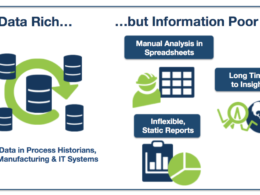Companies are investing in data technology, and hiring more C-level data execs, than ever. So why do so many of them say they struggle to be data-driven?
SalesForce
Lisa Lee, Contributing Editor
April 13, 2022
Companies are investing in data at record levels. Yet even as they add data execs to the C-suite and spend more money to collect, analyze, and store more and more information, many are seeing surprisingly few improvements. Data transformation, unlike digital transformation, has stalled.
- Only 24% of companies say their organization is data-driven,
- only 41% believe they are competing on data and analytics, and
- just 19% say they have established a data culture.
That’s according to the latest executive survey by NewVantage Partners, which has been polling leaders on the topic annually for 10 years.
Why the gloomy numbers on numbers? And how do you actually go from simply having a ton of data to a culture in which that data drives your business?
The majority of respondents in the NewVantage survey cited cultural impediments as the greatest challenge. Getting people to change can be excruciatingly slow and difficult. It can require reengineering business processes, educating your workforce, meeting requirements for data literacy, and increasing alignment across your business.
“Most organizations are not historically set up to manage data as an asset and harness its potential to deliver business value,” said Randy Bean, CEO and founder of NewVantage.
“Chief data officers (CDOs) are also struggling to make the role successful, because it’s a new role, and there is no clear expertise or understanding of the value that can be delivered.”
Many organizations, particularly those not born in the internet era, underestimated the time it would take for data transformation efforts to take effect.
They struggled against the inertia of legacy systems, cultures, skill sets, and mindsets. But this transformation must take place, as customers demand fast, relevant, accurate, personalized interactions with your brand.
Organizations can’t deliver on that if they’re not digital-first and data-first.
To kickstart a data transformation, CDOs need to speak the language of business
There are transformative benefits to unifying your company’s data across channels and departments, and making it available and accessible to every corner of the organization.
That starts, as all transformations do, at the top.
Today, nearly three-quarters of Fortune 1000 companies have a chief data or analytics officer. But too many organizations build data capabilities that are not connected to critical business questions.
As a result, business leaders (the ones who control budgets and organizational initiatives) wind up believing there is little value in investing in them.
“Data leaders need to answer the question of what they need to deliver better customer experience, service, or to enter new markets,” said Bean.
“Then you ask what data you need to answer those questions, and who needs access to that data. If you do that, you’ve established the most important thing, which is trust and credibility with the business.”
A case in point is the fast-growing 5-year-old Danish car subscription company Dribe, whose primary investor hails from the traditional auto industry.
Executives who led companies in the pre-internet era “aren’t inclined to believe data, so you’ve got to do two things: show very specific use cases, and serve the data on a silver platter so it is extremely easy to understand,” said Erik Asbjørn Arvid, Dribe’s chief technology officer.
Bean suggested the following for senior leaders looking to establish a data culture:
- Organizations should hire data executives with a background in organizational change, not just data technology and analytics.
- Companies should work with change management experts to understand barriers to establishing data cultures, and how to remove them.
- Business executives need to promote data-driven decision-making and hire and promote those who practice it.
- These leaders should also celebrate data successes and highlight them at all levels of the organization.
- To get buy-in from business leaders, it’s critical for data executives to articulate the business case for an organizational transformation built around data, including specific examples of business results.
“It’s not enough to say you’ve got the highest IQ or the best algorithm,” Bean said. “You’ve got to make your case demonstrating business value.”
Advanced education programs are emerging to bridge the divide. MIT, Carnegie Mellon and the University of North Carolina-Charlotte, for example, have executive programs that meld the studies of data, analytics, and business.
Data for all, not just the gatekeepers
At too many companies, the only people who manage data are the analysts who specialize in organizing and assessing it. This narrow approach is a key impediment to building a data culture.
After all, how can you establish an organizational norm when only a select few are invited into the club?
To democratize data across all stakeholders, companies need to start by investing in training and data literacy.
- Today, only 39% of companies reported making data training available to all employees,
- even though 80% of employees said they’re more likely to remain with a company if they offer data training.
The ability to access and understand data will yield faster and better informed decisions, and higher-performing, empowered, more agile teams.
The good news is technology has made it possible to not only connect previously disconnected data sources, but also make it shareable, manageable and interpretable to a much broader pool of stakeholders.
These tools, Bean noted, must filter the data so it’s relevant to each person’s role, and be presented in a visual way (such as easy-to-read dashboards) so they are comfortable with it. These visualizations must align with the organization’s key business objectives.
At Dribe, nearly every employee is trained and has access to continuously-updated Tableau dashboards.
For example, business leaders have insight and forecasting into sales, profit and inventory, while portfolio managers rely on algorithms to predict member’s future car needs.
“Training is where you sow the cultural seed,” said Arvid.
Technology isn’t the end game
Global spending on big data and business analytics hit $215 billion in 2021, driven by businesses’ desire for better, faster decisions, according to research firm IDC.
“Leveraging data for insights into everything from internal business operations to the customer journey is top of mind and of strategic importance,” the company noted.
But acquiring the technology, and naming C-level data leaders, will only get you so far.
To become truly data-driven requires a sea change in attitudes at every level, and a commitment to training, promoting and rewarding data literacy across the organization.
“Unless organizations change, the technology really does nothing for the business,” George Westerman, principal research scientist for workforce learning at MIT’s Abdul Latif Jameel World Education Lab, told MIT Sloan.
Organizations should not fall into the trap of deploying technology for its own sake. Data leaders need to help business leaders understand the relationship between data transformation and business strategy.
Companies of all stripes have proven they can pivot fast, and get employees to adopt new ways of working and serving customers. Many companies have been transformed around digital. Now they need to transform around data.
“Data is helping us constantly refine our understanding of who our customers are and what they need. Becoming a data-driven company that revolves around data,” Arvid said, “is a groundbreaking evolution.”
Names mentioned
Randy Bean, CEO and founder of NewVantage.
Erik Asbjørn Arvid, Dribe’s chief technology officer
George Westerman, principal research scientist for workforce learning at MIT’s Abdul Latif Jameel World Education Lab, told MIT Sloan.












